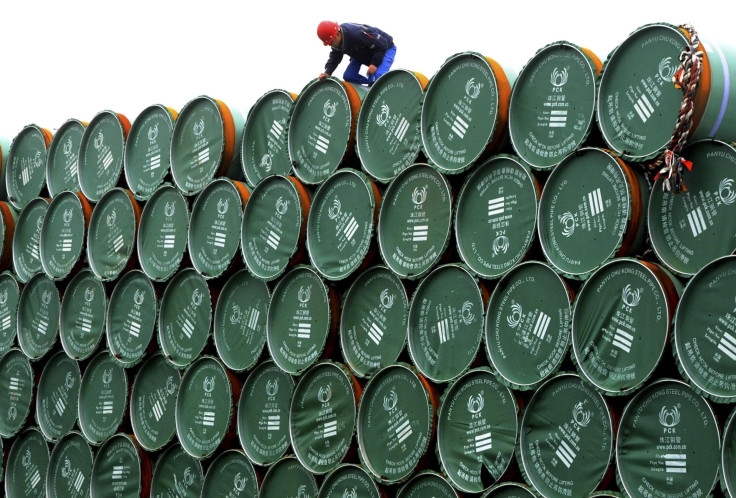China's Rate Cut, Coupled With ECB Stimulus And Lower Oil Prices, Could Boost Global Growth In 2015

China's decision to cut its key interest rates this week underscores just how concerned Beijing is about the slowdown in the world's second-largest economy.
The People's Bank of China cut its benchmark one-year loan interest rate Friday to 5.6 percent from 6 percent and cut its benchmark one-year deposit rate to 2.75 percent from 3 percent. The nation's central bank also hiked the upper limit on deposit interest rates to 1.2 times the benchmark rate from 1.1 times the benchmark rate.
The bank said it took the actions, which were largely unexpected and are the first such changes since July 2012, in response to expensive borrowing costs rather than any direct worries about the economy's slowdown.
But economists attribute the actions to underlying worries about slowing growth.
"Cutting interest rates is a way for Chinese economic policy to cushion the impact of slower economic growth without reopening the credit floodgates," said Bill Adams, senior international economist for PNC Financial Services Group.
The rate cuts also reflect the central bank's view that large enterprises -- not the far more numerous midsize and small companies -- will be the key to preventing the economic slowdown from accelerating.
“This does not necessarily signal that policymakers are going back on efforts to support smaller companies, or giving up on ‘targeted easing,’ but they apparently feel larger firms are now in need of support too,” Mark Williams, chief Asia economist at Capital Economics, said in a note.
Economists also had reservations about whether the rate cuts will succeed. Recent Chinese economic data point to a weaker end to 2014, and suggest gross domestic product growth will likely slow to about 7 percent in 2015 from 7.4 percent in 2014, Adams said. The People's Bank of China currently forecasts 7.5 percent GDP growth in 2014.
“Without any relaxation of those [quantitative] limits, a rate cut simply lowers the cost of credit, but doesn’t increase the amount supplied,” Williams said.
"The impact on GDP growth will be small," Williams said in a note. "The main effect will be to improve the financial position of large firms. At the same time, the wide net interest margin enjoyed by banks will be squeezed."
How China's economy does next year will depend on much more than Friday's interest rate cuts. Following China’s surprise decision Friday, the PBOC along with the Bank of Japan and the European Central Bank have all announced new easing measures after the U.S. Federal Reserve ended its quantitative easing program in October. Despite continuing concerns of a slowdown in global economic growth, the spur in stimulus, coupled with the recent drop in global commodity prices, could be more of a positive than a negative for global growth, as economists now expect the global economy to grow incrementally faster in 2015 than in 2014.
“The biggest global economies, including the U.S., Europe and China, are all more energy consumers than they are energy producers, so lower oil prices mean more disposable income for consumers around the world and they’re a tailwind for GDP growth for 2015,” said PNC Financial Services' Adams.
Also Friday, the ECB said it plans to ramp up stimulus measures as economists fear Europe will fall into a triple-dip recession. “The modest growth that the Eurozone saw in the third quarter demonstrates the Eurozone doesn’t seem to be headed toward a triple-dip recession,” Adams said.
Following the stimulus program the ECB announced Friday, relative to the size of the Eurozone’s economy, its asset purchasing program in 2015 will be around 5 percent of GDP, compared with nearly 7 percent of U.S. GDP from the Federal Reserve’s third round of quantitative easing program at its peak, 10 percent to 12 percent of GDP for the Bank of England’s asset-purchase programs and 18 percent of GDP for the Bank of Japan’s program, Adams said.
Economists predict the ECB’s asset purchases will probably support stronger growth in the Eurozone and could spur a more aggressive program out of the ECB in the next few quarters. “The expanses that they’re seeing now is not enough to bring down the unemployment anytime soon and inflation will continue to undershoot the ECB’s target, but the direction in the Eurozone is the right direction,” Adams said.
As far as China and Europe's impact on the U.S. economy, economists expect the Federal Reserve to remain on course and raise interest rates in the middle of next year as gas prices fall and the labor market continues to improve. "The Fed is not under pressure to pull forward its monetary policy," Adams said. "As the U.S. labor market continues improving, it will likely lead to stronger wage growth in 2015 and 2016."
© Copyright IBTimes 2025. All rights reserved.






















